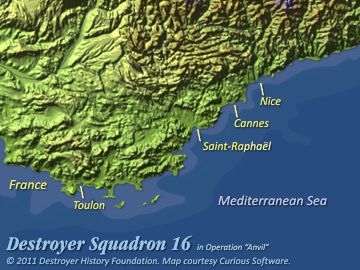
World War II operations of destroyers
originally attached to Squadron 16

The squadron was not yet formed in time for Operation “Torch,” the invasion of North Africa in November 1942, but Parker was attached to DesRon 11 with the Northern Attack Group at Medhia and Boyle to DesRon 13 with the Center Attack Group operating off Fedhala and Casablanca while Laub escorted a convoy. Thereafter, the squadron escorted convoys to North Africa and the Mediterranean Sea. On 12 March 1943, operating as one of seven destroyers with convoy UGS-6 from New York to Casablanca, Champlin sank U-130.
In the Mediterranean for Operation “Husky,” the invasion of Sicily in July 1943, DesRon 16 and DesRon 15 formed the destroyer screen for the attack groups of RAdm Kirk’s Task Force 85. Operating with cruiser Philadelphia and the “Cent” force off Scoglitti—less McLanahan, which operated with Boise, Savannah, DesRon 17 and the “Dime” force off Gela, and Ordronaux, which was assigned a squadron of torpedo boats to patrol outside a minefield off Porto Empedocle and neutralize German S-boats and Italian MAS-boats there—Squadron 16 was effective in silencing shore batteries. On D-day, one salvo from Champlin appeared to have prompted the surrender of a town. The next day, Laub’s accurate fire destroyed four or more tanks of the Hermann Göring panzer division on the plain behind Gela.

DesRon 16 at Sicily, July 1943.
After Sicily, the squadron resumed a routine primarily of convoy duty between the United States and the Mediterranean. It did not participate in the Operation “Avalanche” landings at Salerno, Italy in September but subsequently escorted convoys into the area. On 2 November, a German plane torpedoed Kendrick but damaged only her fantail. On 6 November, Parker, Laub and McLanahan were escorting supply convoy KMF-25A when 25 German bombers attacked off Cape Bougaroun, Algeria. Six Allied ships were damaged or sunk including Beatty; Parker and Laub picked up her crew.
DesRon 16 also missed the Operation “Shingle” landings at Anzio, Italy in January 1944, but was busy in the Atlantic where, on 7 April 1944 south of Halifax, DesDiv 32 hunted a reported U-boat. Forced to the surface, U-856 sank when Champlin rammed her and destroyer escort Huse finished her with gunfire.
The squadron was back off the central Italian coast in May, when Parker bombarded enemy positions between Naples and Anzio and Kendrick and Laub operated with Philadelphia during the breakout from the Anzio beachhead. On the 23rd, when Laub and Philadelphia collided, the two were replaced by French cruiser Emile Bertin and Ordronaux. Later, Kendrick, Parker, Champlin and Kearny took turns supporting the northward advance of Major General Lucian Truscott’s VI Corps.

DesRon 16 off southern France, August 1944.
Squadron 16 less Laub was present with DesRon 13’s Woolsey, Ludlow and Edison in August 1944 for Operation “Anvil,” the invasion of southern France, attached to Rear Admiral Morton L. Deyo’s “Camel” bombardment group off Saint-Raphaël and Cannes.
In 1945, ships of the squadron continued shore bombardments in the Ligurian Sea and operations in the Mediterranean and eastern Atlantic until returning to the East Coast in late spring. In the summer—still less Laub, which was preparing to do so when the war ended—they moved to the Pacific, typically pausing at Pearl Harbor for retraining and then moving forward to Okinawa or Wake Island; finally participating in post-war opertions before returing home to the United States.
Sources: Destroyer History Foundation database, Roscoe, Morison, Dictionary of American Naval Fighting Ships entries for individual ships.